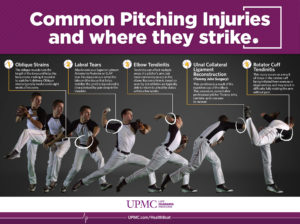 I get this question a lot as a coach, "How Do You Protect Pitchers Arms?" This is obviously a popular question in baseball due to the ever growing injury rates for pitchers. MLB is losing billions of dollars due to this serious problem. Injury will always be apart of this game but we do have the power to stop it from climbing.
I get this question a lot as a coach, "How Do You Protect Pitchers Arms?" This is obviously a popular question in baseball due to the ever growing injury rates for pitchers. MLB is losing billions of dollars due to this serious problem. Injury will always be apart of this game but we do have the power to stop it from climbing.
The challenge is I am not fully convince baseball wants the injury rate to stop growing. There are many medical practices making millions today as a result of the injury rates, along with those businesses benefiting from what is actual causing the injury rates and that is more competition.
In this article, I will respond to the question of how I personally as a coach deal with injury for my pitchers, the system I have built to help them avoid it and if pitch counts are a good league wide solution to stopping the injury rate from growing.
Protect Pitchers Arms: Offseason
Most of my training with pitchers is offseason but I do some phone consultations and programming through their seasons. In the offseason I have had success with my pitchers building strength, mobility and efficient use of the kinetic chain to improving their overall health during the season. I have developed a pitching biomechanics system called 3X Pitching of over 50+ components with links to 3rd party research defining their effects on injury prevention and performance enhancement. I have also developed proprietary drills using a 2lb med ball and baseball to teach and train these pitching components called the 3X Velocity System. You can purchase the 3X Extreme Pitching Velocity Program online here and start this training today.
On top of teaching and training healthier movements in offseason, I also teach my pitchers how to keep their bodies conditioned and healthy through the year, I believe in building joint stability over head with an Olympic lifting approach in the offseason. This would include overhead press, jerks and I add in holds. The Olympic Lifting approach also helps to develop elite core and leg strength/power along with training an efficient kinetic chain. The combination of training in the Olympic style, along with general strength and conditioning, is very powerful when working to keep athletes healthy. I believe strength coaches that isolate most of their lifts and exercises to specific muscles with general movement do not support high performance tri-planar athletes as well as multi-joint high performance exercises and lifts like the Olympic Lifts.
Protect Pitchers Arms: Inseason
In season, I do lower the volume of Olympic Lifting. My programs use a similar rotator cuff training system like the Throwers Ten Program in all seasons of training especially inseason. I do not spend a lot of time in the shoulder working on scapular dyskinesis symptoms with my programming because I believe the relationship to the shoulder and hip is most important for shoulder health. We have a study that found a correlation of shoulder injury and hip range of motion (Scher et al., 2010). We also have a study that found a correlation of hip range of motion and elbow injury (Saito et al., 2014). If I have a pitcher showing signs of scapular dyskinesis, I will first look at their hips and if I their hips are mobile and strong then I will move into more shoulder mobility and strengthening work if needed.
In response to pitch counts at youth level, I like the use of them but it isn’t enough to prevent poor coaching from injuring pitchers. In response to pitch counts at the professional level there is research showing it is a poor predictor of injury (Karakolis, Bhan, & Crotin, 2015). The biggest predictor of injury in my practice is poor pitching mechanics, weak tissue threshold, overuse, poor strength, mobility, power and use of the kinetic chain. Unfortunately, with tri-planar high performance athlete’s injury rarely links to just one thing in my experience.
Protect Pitchers Arms: References:
- Karakolis T1, Bhan S, Crotin RL. Injuries to young professional baseball pitchers cannot be prevented solely by restricting number of innings pitched. J Sports Med Phys Fitness. 2016 May;56(5):554-9. Epub 2015 Mar 18.
- Manabu Saito, PT, Tomonori Kenmoku, MD, PhD, Kentaro Kameyama, PT, Ryo Murata, MD, PhD, Takashi Yusa, PT, Nobuyasu Ochiai, MD, PhD, Takehiro Kijima, MD, Naonobu Takahira, MD, PhD, Kensuke Fukushima, MD, Noriyuki Ishige, MD, PhD, and Masashi Takaso, MD, PhD. Relationship Between Tightness of the Hip Joint and Elbow Pain in Adolescent Baseball Players . Orthop J Sports Med. 2014 May; 2(5): 2325967114532424. Published online 2014 May 12.
- Steve Scher, MSPT, ATC, CSCS, PES, Kyle Anderson, MD, Nick Weber, PT, ATC, CSCS, PES, Jeff Bajorek, ATC, PES, Kevin Rand, ATC, CSCS, and Michael J. Bey, PhD. Associations Among Hip and Shoulder Range of Motion and Shoulder Injury in Professional Baseball Players. J Athl Train. 2010 Mar-Apr; 45(2): 191–197.



